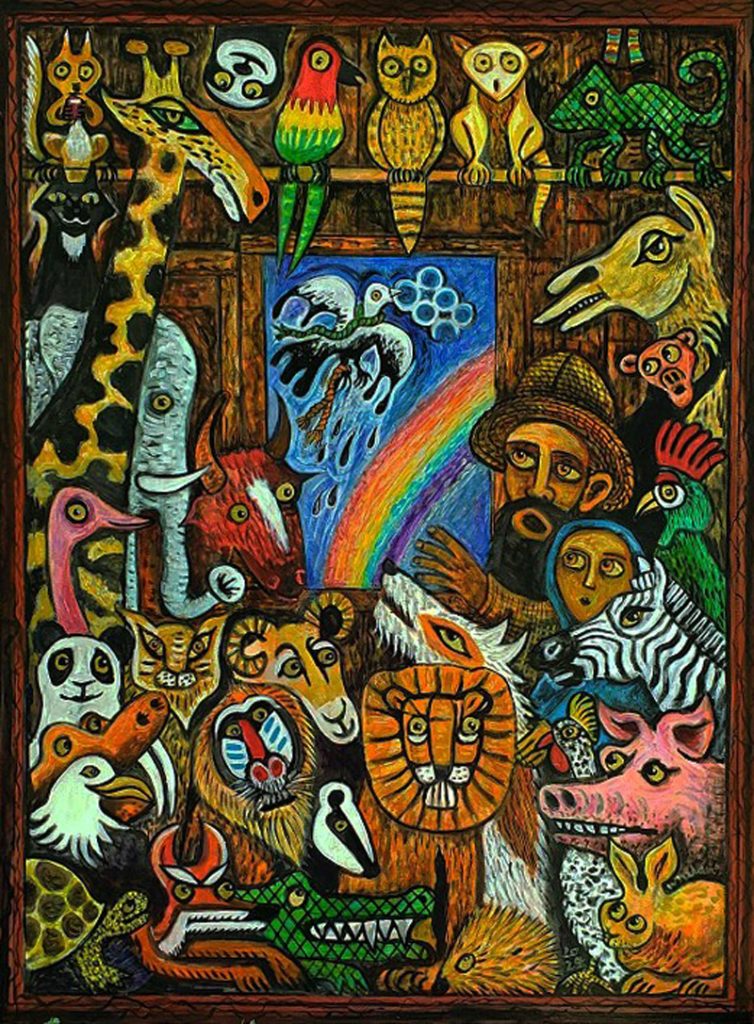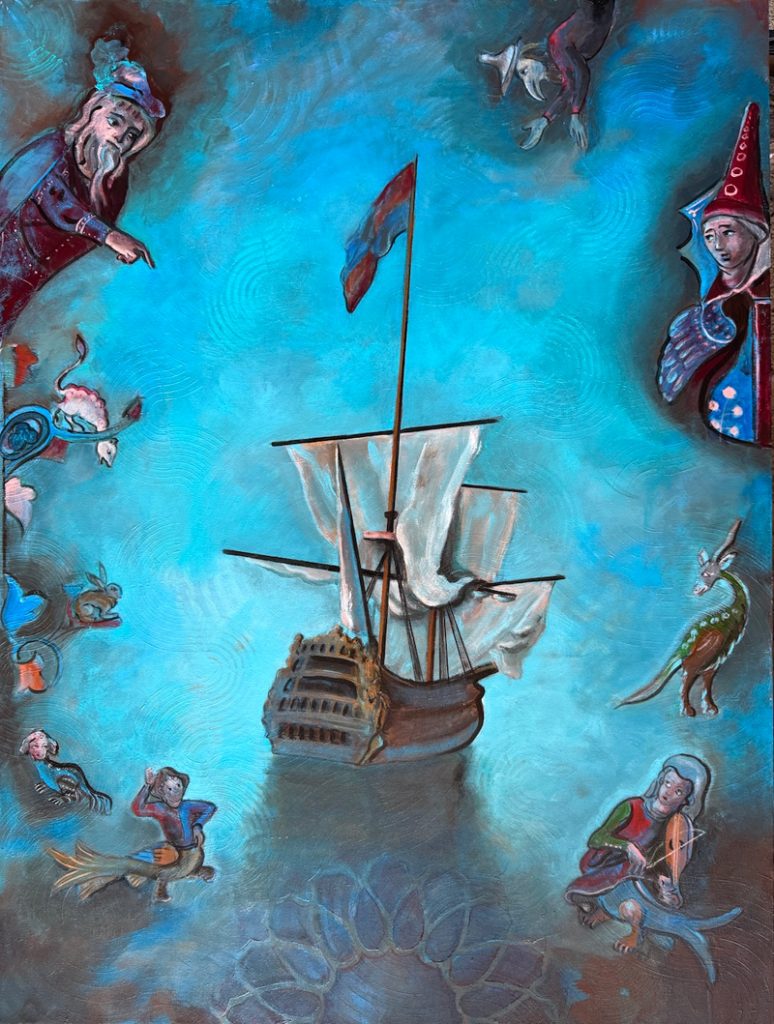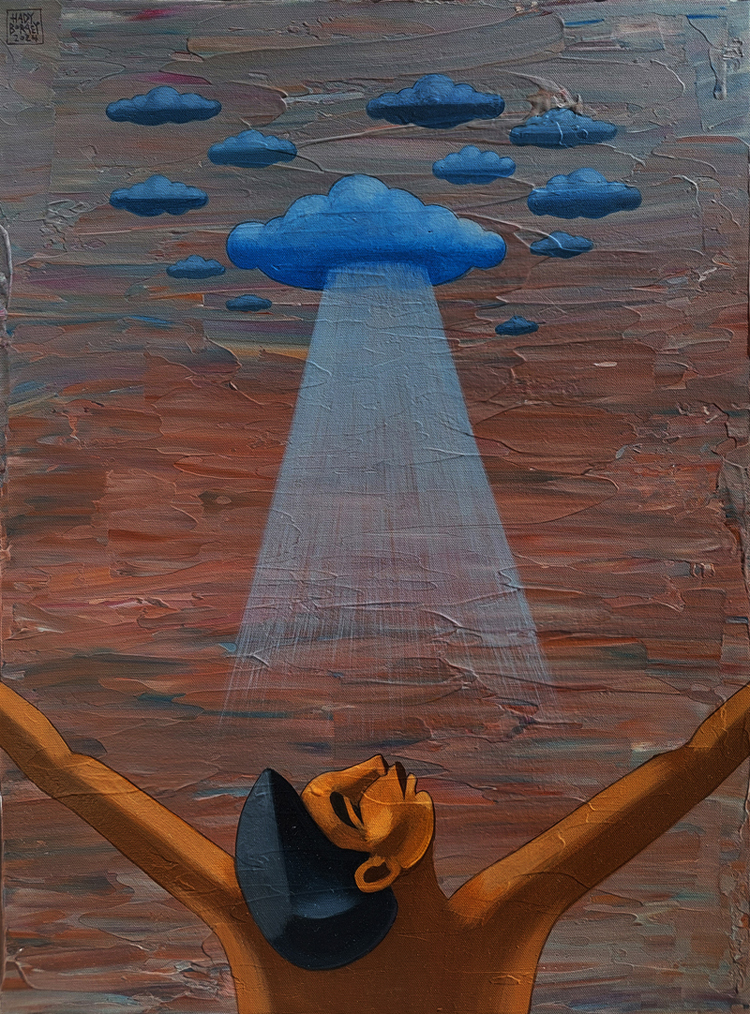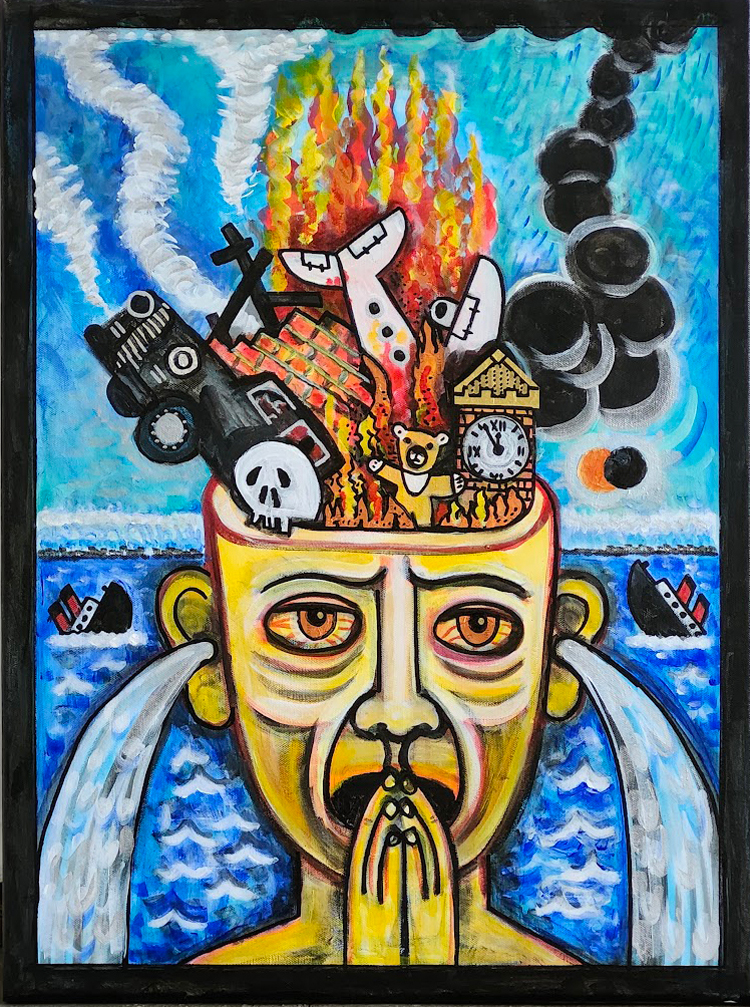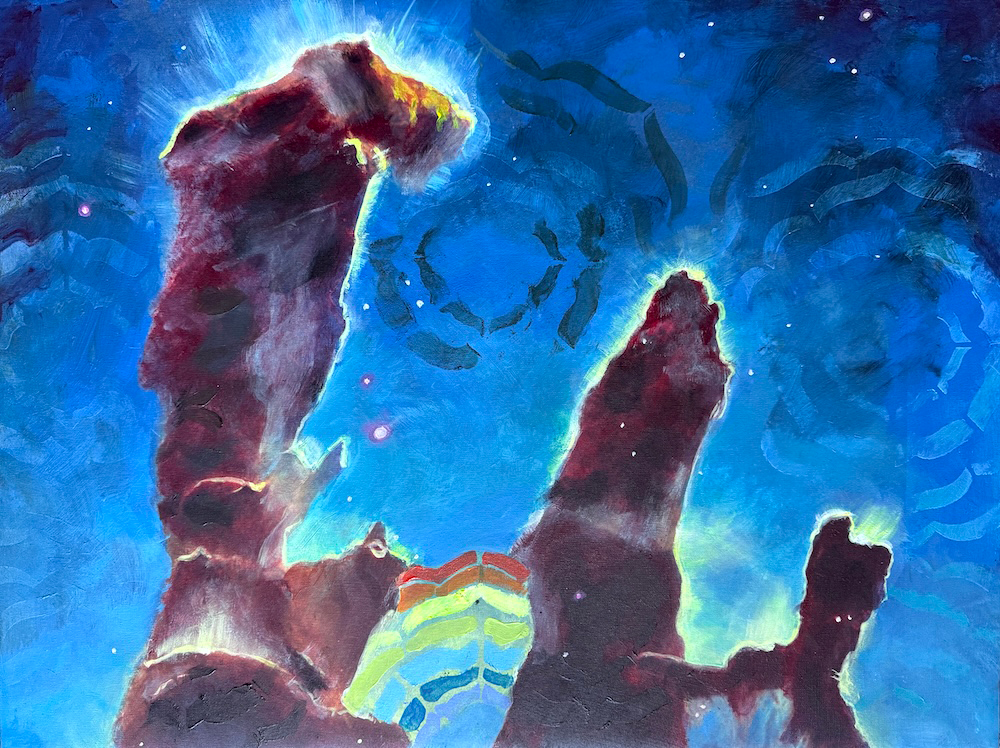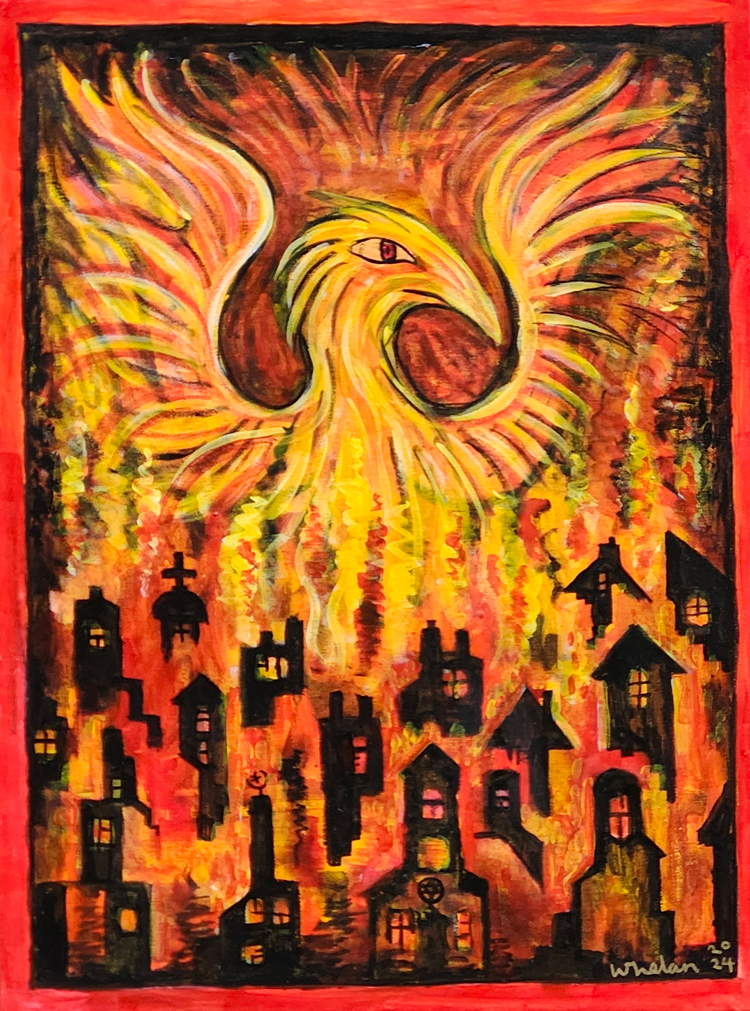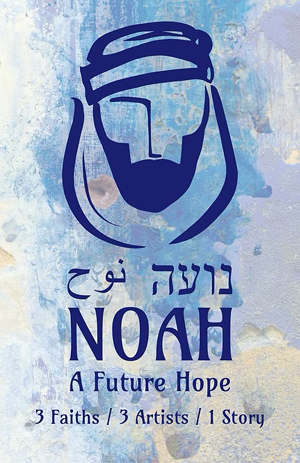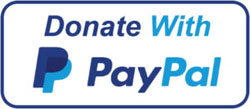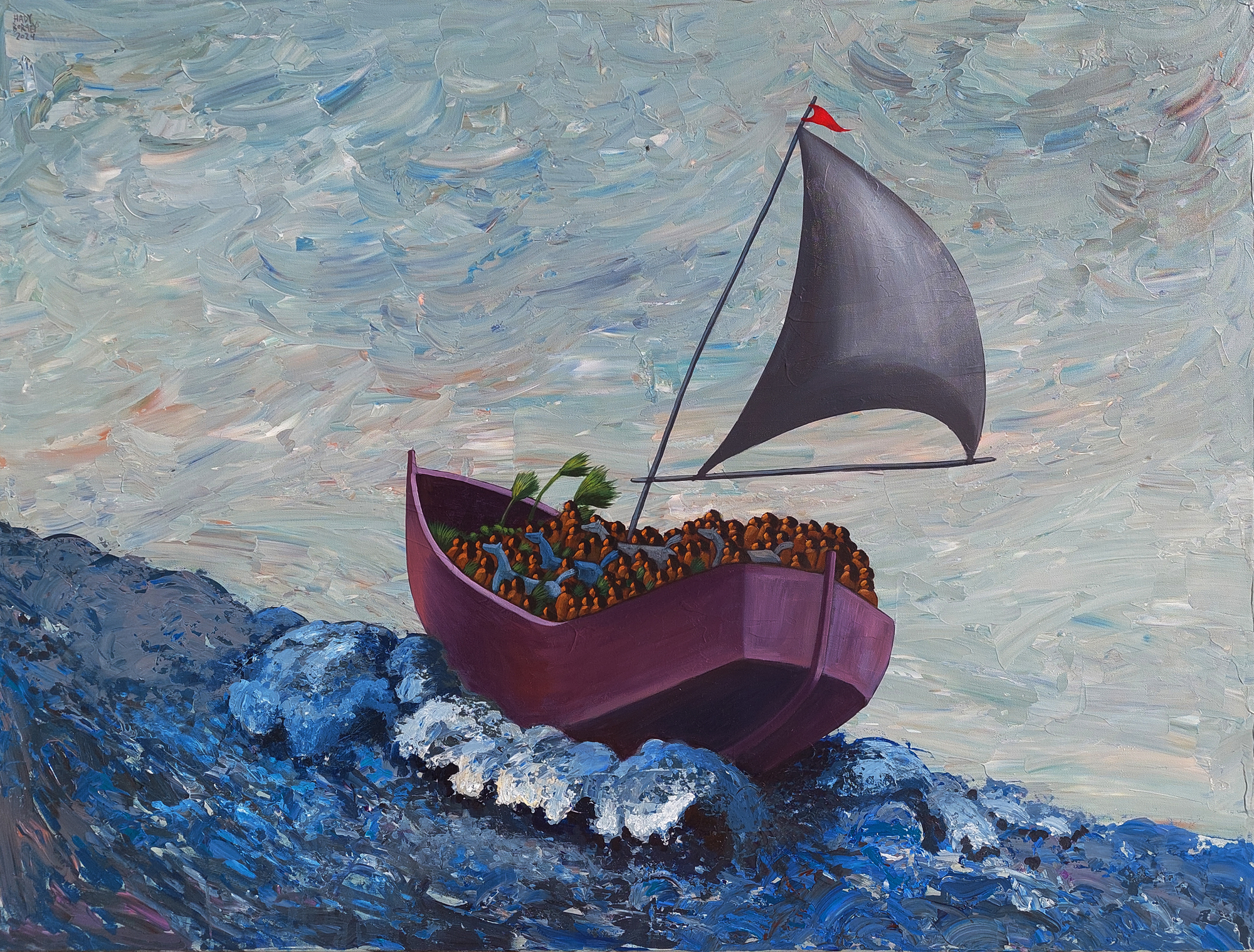
Three faiths, three artists, one story
“In our hands now lies not only our own future,
but that of all other living creatures with whom we share the Earth …
If working apart we are a force powerful to destabilize our planet,
surely working together we are powerful enough to save it.”
—Sir David Attenborough, broadcaster, biologist, naturalist and writer
OUR EARTH IS facing an unprecedented climate crisis. With ecosystems collapsing and weather patterns shifting, we stand at a crossroads, where we are called to restore balance and reawaken our responsibility as stewards of the planet. Amid this global reckoning, the ancient story of Noah offers profound insight and personal solace. Revered across Judaism, Christianity and Islam, Noah emerges as a symbol of moral resolve and sacred duty—a reminder of humanity’s role as protector of life. His ark, therefore, becomes not just a vessel of survival but a testament to hope, unity and renewal.
Organized by CARAVAN and curated by its Founding President Paul G. Chandler, NOAH: A Future Hope is a powerful exhibition exploring seven timeless lessons from this enduring tale. Featuring the work of three premier contemporary artists—Yona Verwer, Brian Whelan and Hady Boraey—it blends Abrahamic faith, culture and creativity in a moving visual journey. Each artist has created eight paintings in total that invite us to honour our deep connection to the Earth and to restore a sacred harmony with all living things.
Opening in autumn 2025, the exhibition will travel for three years across North America, Europe and the Middle East, gracing galleries, cultural centres and sacred spaces with its message of healing, imagination and collective hope.
Biographies
Hady Boraey was born in Behira, Egypt. He holds a PhD and MA in Fine Arts from the Faculty of Fine Arts of University of Alexandria. As a lecturer in the Graphic Department at the University of Alexandria, he specializes in illustration, drawing, manual design, painting, traditional mixed media and installation. He has participated in numerous exhibitions both in Egypt and internationally, such as in the United Arab Emirates, Canada, Italy, UK and Poland.
Brian Whelan grew up in London, of Irish parents. After his training at the Royal Academy of Arts, he lived and worked in the East Anglia area of England near the North Sea. His home and studio are now based in Connecticut, USA. Known to combine the profundity of play with the intent of icons, his paintings have been exhibited in noted art spaces, cathedrals and religious institutions around the world.
Dutch-born New York multidisciplinary visual artist Yona Verwer creates works that explore identity, immigration, ecology, heritage and spirituality. Sourcing from a variety of cultures, she works in a varied range of media and materials, among them painting, installations, new media and video. She holds an MA in Fine Art from the Royal Academy of Art in The Hague and has shown in over 30 museum exhibitions, as well as many galleries, nationally and internationally.
CARAVAN is an international arts NGO/non-profit that is recognized as a global leader in using the arts to build bridges between diverse cultures, peoples and spiritual traditions, toward fostering a more harmonious future, both with each other and with the earth. Its mission is based on the belief that the arts can be one of the most effective mediums to heal our world and to creatively promote peace and harmony, by enhancing understanding, bringing about respect, enabling sharing and deepening relationships between those of different backgrounds and worldviews. Many of CARAVAN’s initiatives have already been featured on The Culturium.
Raised in Senegal, West Africa, Paul G. Chandler is an author, curator, interfaith peacemaker, intercultural bridgebuilder, non-profit executive and authority on the Middle East, Africa and the Abrahamic spiritual traditions. He is also the Founding President of CARAVAN Arts, an international arts non-profit/NGO that uses the arts for transformational purposes. He has organized and curated major art exhibitions internationally and is the author of four books, including his most recent book, IN SEARCH OF A PROPHET: A Spiritual Journey with Kahlil Gibran, which focuses on the artistic spiritual journey of the early 20th-century, Arab-American poet-artist, Kahlil Gibran.
NOAH: A Future Hope is an artistic response to the escalating environmental challenges that we face around the globe. The purpose of this exhibition is to be a creative catalyst that inspires action towards preserving the earth, offering a message of hope for future generations.
Flood stories have been around since humanity first began oral traditions and are prevalent in indigenous cultures around the world. The Sumerians were probably the first to write down their flood stories in The Epic of Gilgamesh in 2,600 BC. While there may be many reasons for the commonality of flood stories, they all remind us that we are subject to the forces of nature and that we depend on the environment for our existence. If there is to be balance, safety and prosperity in our world, we must respect the earth, all living creatures and each other.
The epic story of Noah is one of the most well-known flood stories in history. This quintessential tale is deeply embedded in the faith traditions of Judaism, Christianity and Islam. Within these Abrahamic faiths, Noah is seen as a spiritual figure who serves as a reminder of humanity’s role as a protector, steward and caretaker of the earth. While the story of the ark, its animals and the flood have captured children’s imaginations down through the ages, it takes on contemporary relevance as we face climate change, and can inspire individuals and societies to become active participants in the stewardship of the earth.
This exhibition reflects the enormity of today’s environmental challenges. Sea levels are rising; our world is literally sinking, albeit slower than “40 days and 40 nights”. However, the outcome is similar. Our rapidly changing world is experiencing natural disasters on an unprecedented scale due to climate change and the enormous environmental impact of industrialization and widespread consumerism. These challenges also contribute to destabilizing our world, providing a fertile basis for division.
This artistic initiative is a warning to our human family to make the changes needed toward preventing further catastrophes, and to acknowledge the immense damage that has been done to the earth’s habitat, to animal life and its fragile ecosystems. We have reached a crisis, a tipping point, and it is imperative that people across the globe unite to proactively participate in ensuring a future for the earth and all its life forms. We are reminded that we all are passengers on the same vessel in need of protection, care and a collective commitment to secure a sustainable future for generations to come.
While Noah’s flood story is a cautionary tale of the dangers of irresponsible human behaviour, it also offers the possibility of change and a belief that a better and more responsible future is achievable.
The story of Noah has been featured prominently in art throughout the centuries by a wide range of renowned artists such as Michelangelo, Jan Brueghel the Elder, Edward Hicks, Gustave Dore, Salvador Dali, Sir John Everett Millais, Marc Chagall, Anselm Kiefer and others. NOAH: A Future Hope features three premier contemporary artists from the faith traditions of Judaism, Christianity and Islam whose artistic practices uniquely blend their spiritual, cultural and creative expression—Yona Verwer, Brian Whelan and Hady Boraey. Each artist was invited to create eight paintings that interpret themes from the story of Noah that encourage us to live together as one family to care for our planet. Through seven lessons drawn from Noah’s flood narrative, their artwork serves to visually inspire our imaginations to heal our world by honouring our intricate connection to the earth as our sustainer and by maintaining a sacred balance with all that lives upon it.
Paul G. Chandler
Curator, NOAH: A Future Hope
President, CARAVAN
Lesson One
“The Lord saw that the wickedness of humans was great in the earth …
But Noah found favour in the sight of the Lord.”
(Genesis 6:5, 8)
“Have they not heard the histories of those who have gone before them?”
(Qur’an 9:70)
In the Noah flood story, humankind was ultimately responsible for the disaster.
Humanity’s responsibility is to care for the earth and all of its life.
Lesson Two
“I am going to bring a flood of waters on the earth …
everything that is on the earth shall die.
But I will establish my covenant with you …”
(Genesis 6:17-18)
“We sent forth Noah to his people.
He said: ‘I have come to warn you plainly.’”
(Qur’an 9:70)
Noah was warned of the coming disaster.
Prevention is important and a focus on advocacy is needed
as many do not believe there is a crisis.
Lesson Three
“And God said to Noah …
Make yourself an ark of cypress wood;”
(Genesis 6:13-14)
“Build the ark under Our watchful eyes,
and with Our inspiration.”
(Qur’an 11:37)
We need to prepare for the looming crisis.
Noah prepared for it by building the ark, reminding us that there is a need to focus
on innovation and the development of solutions.
Lesson Four
“And of every living thing, of all flesh,
you shall bring two of every kind into the ark,
to keep them alive with you;”
(Genesis 6:19)
“When our command comes to pass and water wells out from the Oven,
take aboard a pair from every species and the members of your household,
except those of them already doomed.”
(Qur’an 23:27)
Noah took two of every creature and animal into the ark to preserve the species.
We also need to care for all species and highlight the intrinsic value of each—
focusing on biodiversity, such as animal and wildlife.
Noah’s role as a guardian of the animals reflects humanity’s obligation
to protect and preserve the earth’s ecosystems.
Lesson Five
“Then God said to Noah,
‘Go out of the ark, you and your wife and your sons and your sons’ wives with you.
Bring out with you every living thing that is with you of all flesh—
birds and animals and every creeping thing that creeps on the earth—
so that they may abound on the earth and be fruitful and multiply on the earth.’”
(Genesis 8:15-17)
“Noah prayed to Us, and his prayers were graciously answered.
We delivered him, and his household, from the mighty scourge …
‘Peace be on Noah among all men!’”
(Qur’an 37:75, 76, 79)
The Noah flood story reminds us of the need to care for the human family—
saving all peoples in the human family, not just ourselves or our “tribe”.
It is essential that we each recognize our own role in prioritizing the well-being of all peoples.
Our contemporary humanitarian crisis is referred to as “climate migration”
—forced migration by land and sea due to severe climate change.
Caring for the environment is integral to the survival and prosperity of humanity.
Lesson Six
“… on that day all the fountains of the great deep burst forth,
and the windows of the heavens were opened.
The rain fell on the earth forty days
and forty nights.”
(Genesis 7:11-12)
“We opened the gates of heaven with pouring rain
and caused the earth to burst with
gushing springs …”
(Qur’an 54:11)
Climate change is causing our world to be flooded,
as oceans and seas are rising at unprecedented levels.
Global warming is also bringing upon us other natural disasters.
There are numerous ways in which we are being environmentally “flooded”,
such as overpopulation, trash and air pollution.
Lesson Seven
“As long as the earth endures,
seedtime and harvest, cold and heat,
summer and winter, day and night
shall not cease.”
(Genesis 8:22)
“God has brought you forth from the earth like a plant,
and to the earth He will restore you.
Then He will bring you back afresh.
God has made the earth a vast expanse for you,
so that you may roam its spacious paths.”
(Qur’an 71:17-20)
The Noah story draws our attention to the importance of plant life and vegetation of all types.
We are told that God “gave Noah green plants” and that Noah was “a man of the soil”.
The fresh olive branch in the dove’s mouth upon its return to the ark
reminds us of how plant life was preserved during the flood.
The olive branch highlights the critical role plant life plays in restoring a flooded world.
Post Notes
- Feature image: © Hady Boraey, On the Path of Destiny, 2025, Acrylic on canvas, 48” x 36” (123 x 92 cm)
- CARAVAN, NOAH: A Future Hope
- Paul G. Chandler’s website
- Hady Boraey’s website
- Brian Whelan’s website
- Yona Verwer’s website
- Paul G. Chandler: The Canvas of Life
- GROUNDED: Native American Contemporary Art
- SYMBOLS OF LIFE: Beyond Perception
- Hady Boraey: Line of Descent
- Abraham: Out of One, Many
- Kahlil Gibran: Poet, Painter, Prophet
- The Culturium uses affiliate marketing links via the Amazon Associates Programme
